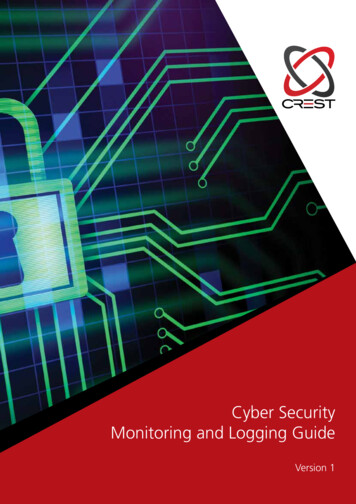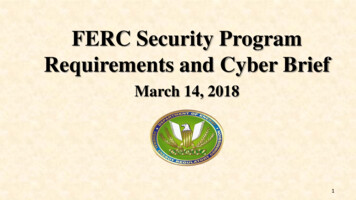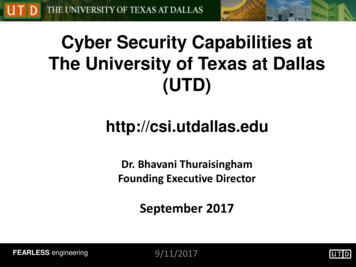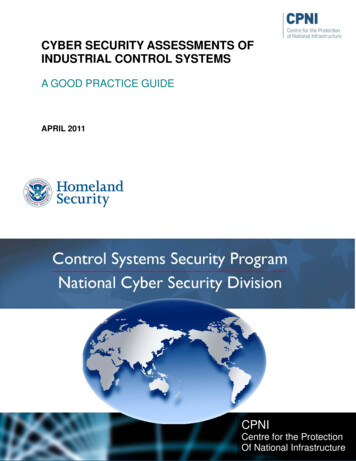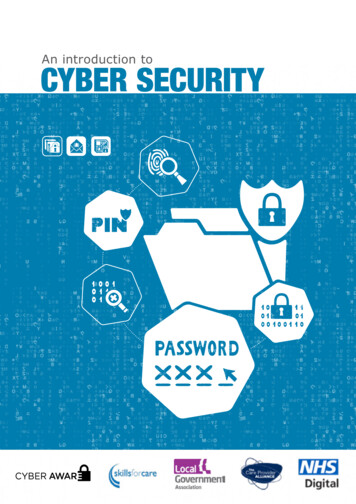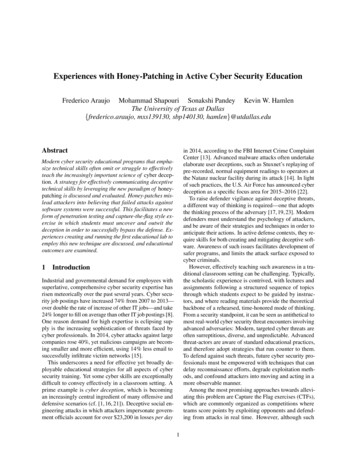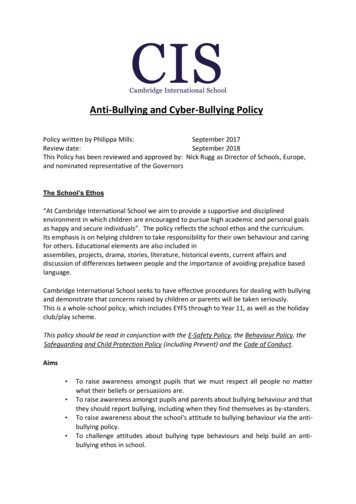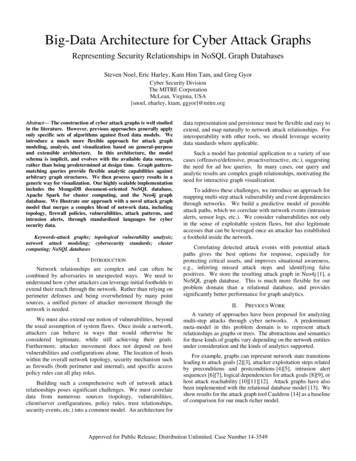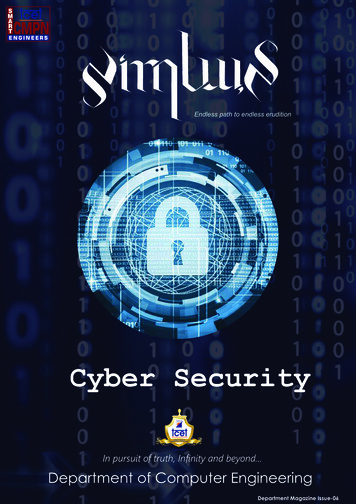
Transcription
SMARTCMPNENGINEERSEndless path to endless eruditionCyber SecurityIn pursuit of truth, Infinity and beyond.Department of Computer EngineeringDepartment Magazine Issue-06
Computer EngineeringDepartmentVISION“To become a department of na onal relevance in the field of Computer Engineering.”MISSIONThe Department of Computer Engineering is commi ed to nurture students with sound engineeringknowledge in the field of compu ng through the effec ve use of modern tools with a focus on globalemployability by imbibing leadership quali es, ethical a tude, lifelong learning and social sensi vity.PROGRAMME EDUCATIONAL OBJECTIVES (PEOs)PEO 1: A ain Sound Engineering knowledge and use of modern tools effec vely to solve real lifeproblems (KNOWLEDGE)PEO 2: A ain need based skills and life long learning to ensure global employability (SKILL)PEO 3: Become successful professionals and responsible ci zens with good leadership quali es andstrong ethical values (PROFESSIONALISM)PROGRAMME OUTCOMES (Pos)PO 1: ENGINEERING KNOWLEDGE: Apply Knowledge of Mathema cs, Science, engineeringfundamentals and an engineering specializa on to the solu on of complex engineering problems.PO 2: PROBLEM ANALYSIS: Iden fy, Formulate, Research Literature and Analyze Complex engineeringproblems reaching substan ated conclusions using first principles of mathema cs, natural sciencesand engineering sciences.PO 3: DESIGN / DEVELOPMENT OF SOLUTIONS: Design solu ons for complex engineering problems anddesign system components or processes that meet specified needs with appropriate considera onfor public health and safety, cultural, societal and environmental considera ons.PO 4: CONDUCT INVESTIGATIONS OF COMPLEX PROBLEMS: Using research based knowledge andresearch methods including design of experiments, analysis and interpreta on of data and synthesisof informa on to provide valid conclusions.PO 5: MODERN TOOL USAGE: Create, select and apply appropriate techniques, resources and modernengineering and IT tools including predic on and modelling to complex engineering ac vi es with anunderstanding of limita ons.PO 6: THE ENGINEER AND SOCIETY: Apply reasoning informed by contextual knowledge to assesssocietal, health, safety, legal and cultural issues and the consequent responsibili es relevant toprofessional engineering prac ce.PO 7: ENVIRONMENT AND SUSTAINABILITY: Understand the impact of professional engineeringsolu ons in societal and environmental contexts and demonstrate knowledge of and need forsustainable development.
PO 8: ETHICS: Apply ethical principles and commit to professional ethics and responsibili es and normsof engineering prac ces.PO 9: INDIVIDUAL AND TEAM WORK: Func on effec vely as an individual, and as a member of leader indiverse teams and in mul -disciplinary se ngs.PO 10: COMMUNICATION: Communicate effec vely on complex engineering ac vi es with theengineering community and with society at large, such as being able to comprehend and writeeffec ve reports and design documenta on, make effec ve presenta ons, and give and receive clearinstruc ons.PO 11: LIFE-LONG LEARNING: Recognize the need for and have the prepara on and ability to engage inindependent and life-long learning in the broadest context of technological change.PO 12: PROJECT MANAGEMENT & FINANCE: Demonstrate knowledge and understanding ofengineering and management and leaders in a team to manage projects and in mul disciplinaryenvironments.PROGRAM SPECIFIC OUTCOMES (PSO)PSO 1: Develop academic ap tude and apply knowledge of compu ng and mathema cs to computerscience problems and thereby design and develop So ware and Hardware Systems.PSO 2: Enhance research skills and u lize advanced compu ng tools for analysis, design andimplementa on of compu ng systems for resolving real life / social problems.PSO 3: U lize mul -disciplinary knowledge required for sa sfying industry / global requirements andhence develop an a tude for life long learning.PSO 4: Have all round personality with skills like leadership, verbal and wri en communica on, teamwork, sensi vity towards society in order to become valued and responsible professionals.
Editorial CommitteeEdi ngMrinal Bageshwari (TE CMPN A)Tejas Gupta (TE CMPN A)Athashree Vartak(SE CMPN B)Saurabh Jha(SE CMPN A)Art DesignSagar Pathare(TE CMPN B)Adit Rathi(SE CMPN B)Faculty MembersDr. Sheetal Rathi, HOD CMPNMs. Harshala Yadav, A.P. CMPNMrs. Ashwini Pa l, A.P. CMPN
Dean’s MessageIt’s the hardwork that has brought this journey a success over the years. I take pride inannouncing the release of the sixth edition of the Nimbus magazine. Nimbus has not onlyproved out to be the best platform for TCET's Computer Department students to showcase theirtechnical knowledge but also their skills of penmanship.The magazine allows students to share their knowledge and ideas in this crpyted field oftechnology and engineering with focus on industry/research areas. Our institute aims atpromoting- writing and publishing skills of students. This helps the students in expressing theirideas in a very persuasive and expressive manner. Gladly, we have turned this into realitythrough our initiative.I would like to congratulate students, teachers and everybody else involved in who took thisopportunity thereby building the soul of Nimbus.Wishing everyone loads of success.Dr. R. R. Sedamkar
HOD’s MessageThe passion to explore, innovate and contribute prevails among the students of TCET andNIMBUS is a reflection of that zeal. Our objective through the departmental magazine is toprovide a platform for the students and staff to transcribe their ideas and research so as tocontribute to the technical knowledge of the readers.In this edition, we destine to throw light on the topic of “Cyber Security”. We hope that thereaders of 6 th edition of Nimbus, will be able to absorb all that we wish to convey while we’vecompiled this issue, considering the hard work and efforts put in by all the stakeholders of thedepartment viz. students, the magazine committee, teachers and industry experts.Congratulations to the committee and the writers for their praiseworthy contribution. Thankyou for your valuable time and efforts worthy of note.Dr. Sheetal Rathi
Faculty Incharge’smessageIn the previous editions of Nimbus we’ve seen topics like an engineer’s traits,. In this editionwe’ll take a look at the contemporary emerging challenge of cyber security.Cyber security is one of the top concerns in today’s world as the world grows digitally. In thisedition, we explore topics that have had huge impacts in everyone’;s lives. Living in aprogressively networked world - from personal banking to government infrastructure,protecting networks has become crucial. We have outlined several threats to cyber security - andthe steps to be taken to generate awareness.Thanks to all our well wishers, and writers for sending us articles. Let me present you with oursixth edition of NIMBUS - “Cyber Security”.Best wishes to all.Ms. Harshala Yadav
FROM THE EDITORS’ DESKAt the very beginning we would like to extend our unfeigned gratitude to our Principal Dr. B KMishra, our Dean-Academics Dr. R R Sedamkar and our Head of Department Dr. Sheetal Rathifor their inspiration and prolific motivation towards the working of this issue of Nimbus.Being a part of Team Nimbus for the last 4 editions we have seen the journey of this magazinefrom being a collection of some articles to a magazine that involves all the stakeholders of thecourse. In this pursuit of knowledge, we have covered many aspects of the field of computersciences which have proven to be helpful to our readers to understand new concepts and think ina new direction with positive intent altogether.This edition is aimed at educating engineers about the growing field of CYBER SECURITY, andhow technology is being used for its implementation, thus developing insights in those areasthat are not extensively taught in constraint to the syllabus. Topics like Cyber Terrorism, DataBreach, Cryptography, Mobile Protection and many case studies of potential threats and recentattacks are being addressed in this edition.On a closing note I would give special thanks to the faculty in-charge of this issue Ms. HarshalaYadav for her easy-going support and motivation and our team of editors and designers for theirmotivated and eager attitude to their work and in making sure, that Nimbus maintains itsstandard it has set through the previous issues, by bringing in phenomenal content. Withoutthem, this issue would have remained what we dreamt it to be.Tejas Gupta & Mrinal BageshwariCo-EditorsSagar PathareHead Designer
IndexFacultyRansomwareStudentAn Overview of Cyber SecuritySecurity: An illusionRecent Infrac ons in Cyber SecurityCyber Security- The First line of DefenceData BreachNetwork Security & CryptographyMul level Network SecuritySecurity Assessment Model Infrastructure as a Service (IaaS) CloudsWebsite SecurityMobile SecurityMobile ForensicsHow Password Hashing improves SecurityPassword ManagersCyber TerrorismCyber Terrorism CasesZero day a ackThe Latest Global Cyber A ack: RansomwareTop Ransomware A acksCryptocurrenciesBitcoin "A Peer-to-Peer Network”Block ChainAre we at the verge of a security apocalypse by Ar ficial Intelligence?IndustryCareer Opportuni es in Cyber SecurityAchievementsStudent Editorial Commi eeAcknowledgments
FACULTYIt is a type of malicious so ware from cryptovirology that is designed and used to threatensthe vic ms to broadcast the data or block access to a computer system un l a sum of money ispaid. The inten on for ransomware a acks is nearly always monetary, and unlike other typesof a acks, the vic m is usually no fied that an a ack has occurred and is given instruc onsfor how to recover from the a ack. Recovering the files a er the a ack without thedecryp on key is an intractable problem and payment is demanded in digital currencies suchas Ukash and Bitcoin, which makes tracing and prosecu ng the perpetrators difficult.Ransomware malware is typically carried through malicious emaila achments, infected so ware apps, infected external storage devices and compromisedwebsites that are disguised as a legi mate file that the user is tricked into downloading oropening. In a ransomware a ack, the malware may change the vic m's login creden als for acompu ng device; in a data kidnapping a ack, the malware may encrypt files on the infecteddevice, as well as other connected network devices.Examples of ransomware1. CryptoLockerEncryp ng ransomware was ac ve on the internet from September through May of thefollowing year, which generated a 2048-bit RSA key pair and a security firm gained right ofentry to a command-and-control server used by the a ack and improved the encryp on keysused in the a acks. The malware defenseless to delete the private key if a compensa on ofBitcoin or a pre-paid cash voucher was not made within 3 days of the infec on. Due to theenormously large key size it uses, analysts and those affected by the Trojan consideredCryptoLocker extremely difficult to repair.
2. CryptoWallCryptoWall first appeared in 2014. One strain ofCryptoWall was dispersed as part of an adver singcampaign on the Zedo ad network in lateSeptember 2014 that targeted numerous majorwebsites; the ads redirected to crook websitesthat used browser plugin exploits to download thepayload. A Barracuda Networks researcher alsodis nguished that the payload was signed with adigital signature in an a empt to appear honest tosecurity so ware. CryptoWall 3.0 used a payloadwri en in JavaScript as part of an emaila achment, which downloads executablesmasquerading as JPG images. To further avoiddetec on, the malware creates new instances ofexplorer.exe and svchost.exe to converse with itsservers. When encryp ng files, the malware alsodeletes quan ty of shadow copies and installsspyware that steals passwords and Bitcoinwallets.accounts of data having been decrypted a erpayment).Ransomware preven onTo look a er against ransomware a acks andother types of cyberextor on, experts adviseusers to back up compu ng devices on a usualbasis and update so ware -- including an virusso ware on a regular basis. End users should beaware of clicking on links in emails from strangersor opening email a achments. Vic ms should doall they can to stay away from paying ransoms.While ransomware a acks may be nearlyimpossible to stop, there are important datap ro te c o n p ro c e e d i n g s i n d i v i d u a l s a n dorganiza ons can take to ensure that harm isminimal and healing is a quick as possible3. WannaCryWannaCry spread through the Internet, using anexploit vector named EternalBlue was able toinfect and encrypt more than 230,000 computersin systems globally and using 20 differentlanguages to demand money from users usingBitcoin cryptocurrency. The malware usesasymmetric encryp on so that the vic m cannotreasonably be expected to make progress the(private and undistributed) key needed to decryptthe ransomed files.During the broad of the week in which WannaCrywas most dangerous, only about 100,000 inbitcoin was transferred (to no avail: There are noGautam Kumar V. JhaFacultyCMPN
STUDENTAn Overview ofCyber SecurityWe have heard of various social crimes but hearing about Cyber Crimes is strange . Weinstall CCTV cameras and other security devices to overcome social crime but what aboutour ac vi es done on computer ,our browsing datas , etc. are they save? Unfortunately theanswer is no. As technology is hi ng its target , it is giving rise to various other problems likeCyber Crime. To tackle the problem of Cyber Crime , Cyber Security comes into picture.Cyber Security is basically set of techniques adapted for protec ng computers, networks,programs and data from unauthorized access or a acks that are aimed for exploita on.Major areas covered in cyber security are applica on security, informa on security,disaster recovery, network security.Applica on security encompasses measures or counter-measures that are taken during thedevelopment life-cycle to protect and deal with the threats that can come through flaws inthe applica on design, development, deployment, upgrade or maintenance. Some basictechniques used for applica on security are input parameter valida on , user/roleauthen ca on & authoriza on, session management, parameter manipula on &excep on management and audi ng and logging.Informa on security protects informa on from any unauthorized access in order to avoididen ty the and to protect privacy . Major techniques used to cover this are iden fica on,authen ca on & authoriza on of user , cryptography.Disaster recovery planning is a process that includes performing risk assessment,establishing priori es, developing recovery strategies in case of a disaster. Any businessshould have a concrete plan for disaster recovery to resume normal business opera on asquickly as possible a er any sort of disaster.Network security includes ac vi es to protect the usability, reliability, integrity and safetyof the network. Effec ve network security targets a variety of threats and thereby preventsthem from entering or spreading on the network. Network security components includean -virus and an -spyware , firewall, to block unauthorized access to your network , virtualprivate networks (VPNS), to provide secure remote access .
But at the same me ques on arises that whycyber security has become an important issuetoday .well, it is because we all live in a worldwhich is networked together, from internetbanking to government infrastructure, and thus,network protec on is no longer an op onal extra.Cyber a ack is now an interna onal concern, ashigh-profile breaches have given many concernsthat hacks and other security a acks couldendanger the global economy. A cyber-a ack is adeliberate exploita on of computer systems,technology dependent enterprises and networks.Cyber a ackers use malicious code and so wareto alter computer code, logic, or data, resul ng indisrup ve consequences that can compromisedata and lead to Cyber Crimes such as informa onand iden ty the or system infiltra on.Cyber Crime thereby makes Cyber Security to bethorough and seamless, regardless of businesssize or organiza onal standing. Computernetworks will forever be the target of criminals,and it can be argued that the danger of CyberSecurity breaches will only increase in the futureas networks con nue to expand. It is also veryimportant to impose strict ac ons by thegovernment if any private data is accessed by anyunauthorized user. Having the right level ofprepara on and specialist assistance is vital tominimize and control damage, and recover from aCyber breach and its consequences thus cybersecurity has become an important issue todaywhich is to be taken care of.Cyber Crime is unlikely to slow down, despite ofconstant efforts taken by the government and bythe specialists. Its growth is being driven by theexpanding number of services available online,and the increasing evolu on of online criminalswho are engaged in a con nuous game withsecurity experts .With constant technicalinnova on, new dangers are constantly coming tothe surface. For instance , the migra on of data tothird-party cloud providers has created ane p i c e nt re o f d ata a n d t h e refo re , m o reopportuni es to misappropriate cri calinforma on from a single target.Aishwarya GuptaSE-CMPN-A
STUDENTSecurity: An IllusionWikiLeaks' Vault7 issue of leaked CIA documents specifying its hacking tools disclosesmalware called OutlawCountry that targets Linux based systems.OutlawCountry is defined in documents dated June 4, 2015 as a kernel module for Linux 2.6that permits CIA operators to redirect outbound traffic to the server they control by makinga hidden ne ilter or iptables table. Ne ilter is packet-filtering framework within the Linuxkernel's networking stack.The recent ransomware a ack, which affected organiza ons around the globe includingBritain’s Na onal Health Service, was the first real illustra on. Criminal hackers exploited afault in ‘re red’ Microso so ware, which is not regularly updated for safety, to infectcomputers with the WannaCry ransomware.But what if devices were even weaker, running with no built-in security and no opportunityto patch? This is the problem that that the so-called internet of things (IOT) presents. Withan predicted 22.5 billion devices due to be connected to the internet by 2021, the chancefor holding these devices to ransom will present significant opportuni es to hackers andwill have severe consequences for providers and users of these devices.Last year the huge Distributed Denial of Service (DDoS) a ack that brought down the DynDomain Name System (DNS) service demonstrated the vulnerability of certain pla orms toa acks using the IoT. During that a ack the commi ers managed to deny access to majorpla orms like Twi er, Ne lix and Facebook for some hours. It was made possible throughbinding poorly protected household devices such as security CCTV and baby monitorswhich s ll had the factory password programmed or no built in security.
This a ack was significant and cost Dyn clients butit didn’t have an effect on infrastructure such ashospitals and doctors’ surgeries in the way,current a ack has, where denying access topa ent records could deferral vital treatment. Butthe IOT has had and could have further significantphysical consequences, even the most placid ofobjects can be weaponized.Self-driving cars are already being examined onthe streets and it is likely that there will be 10.5million self-driving cars on the roads by 2021. Selfdriving cars are part of the so called Internet ofAutomo ve Things (IoAT), a network of sensorsand computer processes that will reduceaccidents caused by human mistake andeventually make the roads a safer place. They willalso be securely designed and protected with thecapacity to cover and update security so warebut they will not be impervious to hacking.The advancement in technologies will alway
campaign on the Zedo ad network in late-September 2014 that targeted numerous major websites; the ads redirected to crook websites that used browser plugin exploits to download the payload. A Barracuda Networks researcher also disnguished that the payload was signed with a digital s
